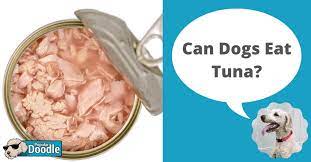Can Your Dog Safely Eat Tuna? Here’s What Experts Say at 2024

Considering tuna as a food option for your dog? It’s a decision that many pet owners ponder, intrigued by the nutritional benefits and potential appeal of this seafood staple. Tuna, known for its high protein content and rich omega-3 fatty acids, is often considered to supplement a dog’s diet, offering benefits like muscle development support and enhanced coat health.
Pet owners frequently turn to tuna due to its convenience and perceived health benefits, aiming to provide their dogs with a balanced and nutritious diet. However, navigating the complexities of pet nutrition requires expert guidance to ensure optimal health outcomes. Veterinary opinions play a crucial role in understanding the suitability of tuna for dogs, addressing concerns such as mercury levels, appropriate serving sizes, and potential allergic reactions. By seeking expert insights, pet owners can make informed decisions that prioritize their dog’s well-being while incorporating tuna responsibly into their dietary repertoire.So now,let’s explore that-can dogs eat tuna?
Nutritional Advantages of Tuna for Dogs
It is a nutrient-rich food that can offer various health benefits for dogs when included in their diet in moderation. Here are the key nutritional advantages of tuna for dogs.
High-Quality Protein Supporting Muscle Growth and Repair
- Amino Acids: It provides essential amino acids necessary for building and repairing muscle tissues.
- Lean Protein: Helps maintain a healthy weight and supports overall energy levels.
Omega-3 Fatty Acids Enhancing Skin, Coat, and Joint Health
- Anti-Inflammatory Properties: Omega-3s help reduce inflammation, benefiting joint health.
- Healthy Skin and Coat: Promotes a shiny coat and healthy skin, reducing issues like dryness and itching.
Essential Vitamins and Minerals
- B Vitamins: Important for energy metabolism and overall vitality.
- Potassium: Supports proper muscle function and fluid balance.
- Magnesium: Crucial for bone health and enzyme function.
Low in Saturated Fats, Contributing to Heart Health
- Heart-Friendly: Low saturated fat content helps maintain cardiovascular health.
- Healthy Weight: Assists in keeping a healthy weight, reducing the risk of heart disease.
Including it in your dog’s diet can provide these nutritional benefits, contributing to their overall health and well-being.
Health Risks and Expert Concerns
While tuna offers numerous nutritional benefits for dogs, there are also significant health risks and concerns to be aware of. Here are some of the primary issues experts highlight when it comes to feeding tuna to dogs.
Mercury Contamination and Its Potential Toxic Effects
- Bioaccumulation: Tuna, especially larger species, can accumulate high levels of mercury.
- Toxicity Symptoms: Mercury poisoning can lead to lethargy, vomiting, and loss of coordination.
- Long-Term Risks: Regular consumption of mercury-contaminated tuna can result in chronic health issues.
High Sodium Levels, Especially in Canned Tuna
- Excess Salt: Many canned products contain added salt, which can be harmful to dogs.
- Health Risks: High sodium intake can lead to excessive thirst, frequent urination, and high blood pressure.
- Dehydration: Elevated sodium levels can cause dehydration and electrolyte imbalances.
Risk of Parasitic Infections from Raw or Undercooked Tuna
- Parasites: Raw tuna can harbor parasites that pose health risks to dogs.
- Bacterial Infections: Undercooked fish may contain harmful bacteria like Salmonella and Listeria.
- Safe Preparation: Proper cooking is essential to eliminate these parasites and bacteria.
Potential for Allergic Reactions in Some Dogs
- Food Allergies: Some dogs may have allergies to fish proteins, including those found in tuna.
- Symptoms: Allergic reactions can include itching, swelling, and gastrointestinal upset.
- Testing and Monitoring: It’s important to introduce tuna gradually and monitor for any adverse reactions.
Understanding these health risks and concerns is crucial for making informed decisions about including it in your dog’s diet.
Expert Guidelines for Feeding Tuna
Feeding it to dogs can provide nutritional benefits but requires careful consideration of preparation methods and serving guidelines to ensure their health and safety. Here are expert guidelines to help you navigate the inclusion of tuna in your dog’s diet responsibly.
- Recommended Types : Fresh vs. Canned (in Water, No Added Salt)
- Fresh Tuna: Opt for fresh tuna whenever possible to minimize potential additives and preservatives.
- Canned Tuna: Choose varieties packed in water and without added salt to reduce sodium intake.
Appropriate Serving Sizes Based on Dog Size and Activity Level
- Small Dogs: 1-2 tablespoons of tuna per serving.
- Medium Dogs: 2-3 tablespoons of tuna per serving.
- Large Dogs: 3-4 tablespoons of tuna per serving.
- Giant Dogs: 4-5 tablespoons of tuna per serving.
Frequency Recommendations to Avoid Overconsumption
- Occasional Treat: Limit tuna to once or twice a week to prevent mercury accumulation and other health risks.
- Balanced Diet: Use tuna as a supplement to a balanced diet rather than a primary protein source.
- Safe Preparation Methods: Cooking Thoroughly, Avoiding Seasonings
- Thorough Cooking: Cook tuna thoroughly to eliminate parasites and bacteria that may be present.
- Avoid Seasonings: Refrain from adding seasonings, additives, or oils that could be harmful to your dog’s digestive system.
By following these expert guidelines, you can safely incorporate tuna into your dog’s diet, providing them with nutritional benefits while minimizing potential health risks. Always consult with your veterinarian for personalized advice based on your dog’s specific health needs and dietary requirements.
Signs of Adverse Reactions or Overconsumption
Monitoring your dog for signs of adverse reactions or overconsumption when feeding them tuna is crucial for their well-being. Understanding these indicators can help you take prompt action to ensure their health remains optimal. Here are the key signs to watch out for:
Symptoms of Mercury Poisoning
- Lethargy: Unusual tiredness or lack of energy.
- Vomiting: Persistent or frequent episodes of vomiting.
- Loss of Coordination: Difficulty walking or maintaining balance.
Indicators of Sodium Overdose
- Excessive Thirst: Increased water intake beyond normal levels.
- Frequent Urination: More frequent trips outside to urinate.
- Diarrhea: Loose or watery stools.
Signs of Allergic Reactions
- Itching: Scratching or excessive licking, particularly around the face and paws.
- Swelling: Swollen face, lips, or tongue.
- Gastrointestinal Upset: Vomiting, diarrhea, or abdominal discomfort.
Long-Term Health Concerns from Regular Overconsumption
- Mercury Accumulation: Potential buildup of mercury in tissues over time.
- Sodium Imbalance: Chronic high sodium intake can lead to kidney issues and high blood pressure.
- Allergic Sensitization: Continued exposure may exacerbate allergic responses.
Being vigilant about these signs can help you identify any potential issues early on and seek appropriate veterinary care if needed. Always monitor your dog’s health closely and consult with a veterinarian for personalized advice on their diet and health management.
Alternatives and Expert Recommendations
When considering dietary options for your dog, exploring alternatives to tuna can offer both nutritional diversity and potential health benefits. Here, we discuss expert recommendations on alternatives and their implications for your dog’s diet.
Comparison with Safer Fish Options
- Salmon: Rich in omega-3 fatty acids and high-quality protein, beneficial for skin, coat, and joint health.
- Sardines: Packed with omega-3s and low in mercury, promoting heart and brain health.
- Whitefish: Low in fat and calories, rich in essential nutrients like protein and B vitamins.
Emphasizing a Balanced Diet with Variety
- Protein Diversity: Incorporating various protein sources helps ensure a well-rounded nutritional profile.
- Nutrient Balance: Different fish provide distinct vitamins and minerals that contribute to overall health.
- Preventing Sensitivities: Rotation of protein sources may reduce the likelihood of developing food allergies.
Importance of Consulting a Veterinarian
- Individualized Advice: Veterinarians can provide tailored recommendations based on your dog’s age, breed, and health status.
- Monitoring Health: Regular check-ups ensure dietary changes are suitable and address any emerging health concerns.
- Professional Guidance: Helps navigate specific dietary needs and potential risks associated with certain foods.
Summary of Key Points
- Moderation: Rotating fish varieties and limiting frequency reduce the risk of overconsumption and associated health issues.
- Safety: Proper preparation and portion control ensure dogs receive nutritional benefits without compromising health.
- Nutritional Benefits: Each alternative fish offers unique advantages, supporting different aspects of canine health.
Exploring these alternatives with guidance from your veterinarian ensures you make informed decisions that prioritize your dog’s nutritional needs and overall well-being.




